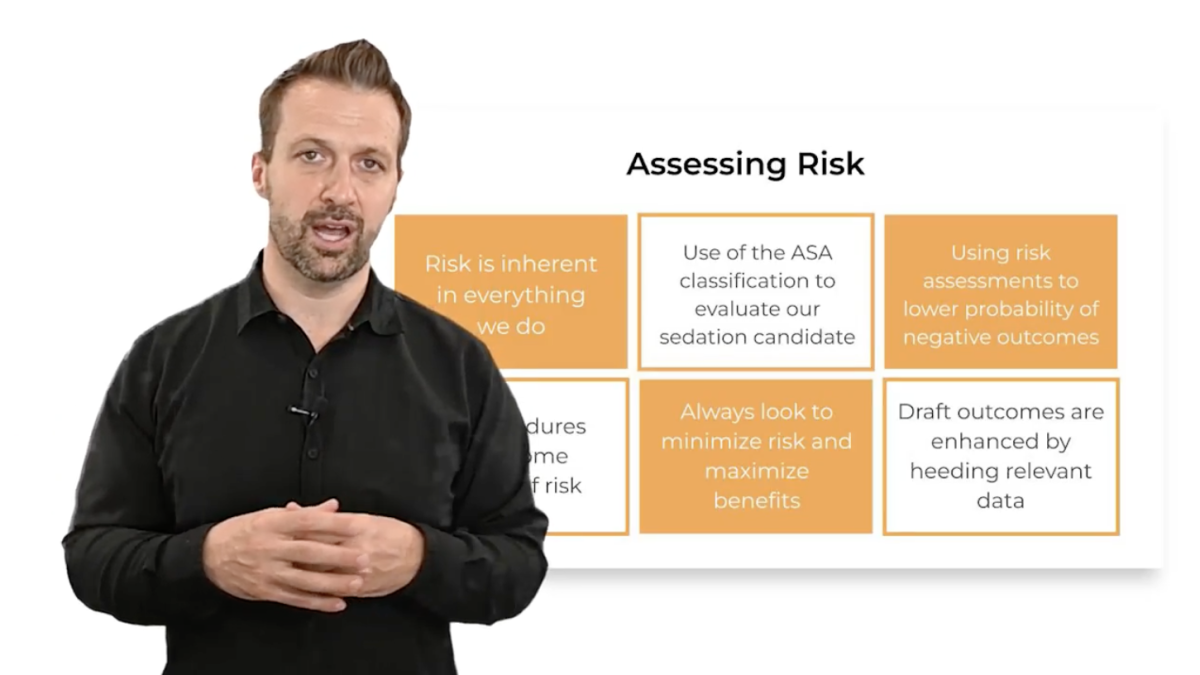How to Decide if a Dental Patient Is Safe to Sedate: Real-World Risk Assessment for Dentists

When it comes to sedation, the big question isn’t just what medications to give or what monitor to use. The real question is: Should I be sedating this patient at all? In this blog, we’re breaking down how dentists can use medical history, physical exams, and ASA classification to make safe, informed decisions before sedating a patient—especially in-office.
Why Risk Assessment Matters
Every time we sedate a patient, we take on risk. That risk could come from an allergic reaction, airway compromise, or even undiagnosed health issues. But the key to minimizing those risks? Doing your homework. That means digging into the patient’s health history and doing a thorough physical exam before you sedate.
This isn’t just theory. In a review of pediatric anesthesia claims dating back to the 1970s, two-thirds of all cardiac arrests under sedation occurred in patients classified as ASA 3 or higher. And of those, 37% died. Compare that to patients classified as ASA 1 or 2—only 4% of them who experienced cardiac arrest died. The numbers don’t lie: higher ASA equals higher risk.
The ASA Classification System: What It Tells You
The ASA classification system has been around since the 1940s. It helps providers categorize patient risk from ASA 1 (healthy) to ASA 6 (brain-dead organ donor). For in-office dental sedation, you should generally only be treating ASA 1 and ASA 2 patients.
Here’s how the classifications break down in plain language:
- ASA 1: Healthy patient. No medical issues, no medications, nonsmoker.
- ASA 2: Mild systemic disease that’s well controlled—think controlled asthma, type 2 diabetes managed with medication, or mild obesity (BMI 30–40).
- ASA 3: Moderate to severe systemic disease—like uncontrolled diabetes, morbid obesity (BMI >40), poorly controlled epilepsy, or a patient with alcohol dependency.
- ASA 4: Severe systemic disease that’s a constant threat to life—recent stroke or heart attack, active sepsis, or end-stage organ failure.
The Diabetic Adult Patient
Let’s say a 37-year-old male comes into your office for moderate sedation. He has type 2 diabetes and takes Trulicity. On physical exam, everything seems normal. But when you dig deeper, his fasting glucose is 166 mg/dL and his HbA1c is 9.6%. He also admits he’s inconsistent with his meds. That’s a red flag.
Even though he’s technically managing his diabetes with medication, the poor control bumps him to ASA 3. In this case, he’s not a good candidate for in-office sedation. He needs medical follow-up and better glycemic control first.
The Teen with ADHD
Now imagine a 13-year-old female scheduled for extractions. She takes Adderall XR for ADHD and occasionally uses Zyrtec for allergies. Her vitals are normal, physical exam is clear, and she’s not taking meds on the day of the procedure. That’s an ASA 2. Mild systemic issues, but nothing poorly controlled. With proper monitoring and no drug interactions, she’s likely a good candidate for in-office sedation.
When Physical Exams Change the Plan
Let’s say you’ve seen a patient before, and you already decided they’re ASA 2. But on the day of the procedure, your physical exam reveals new wheezing or signs of illness. That same patient could now be ASA 3. This is why same-day assessment is critical—it’s not just about what’s in the chart, it’s what you observe that day.
Red Flags That Should Always Trigger a Consult
There are certain conditions that should always prompt you to reach out to a medical provider before moving forward:
- Cardiac history – valve replacements, congenital defects, or recent MI
- Pulmonary issues – asthma with ER visits, chronic bronchitis, or oxygen use
- Cancer treatment – recent chemo or unknown immune status
- Liver or kidney dysfunction – especially with medications metabolized through these organs
- Psychiatric meds – mood stabilizers or psychoactive drugs with sedative side effects
- Drug interactions – always check a database like Medscape before sedation
Don’t rely solely on what parents or patients say. They’re not always accurate historians. When in doubt, get the consult.
Fasting Guidelines: What to Know Before You Start
Sedating on a full stomach increases the risk of aspiration. These are the standard fasting guidelines from the American Society of Anesthesiologists:
- Clear liquids: Stop 2 hours before
- Breast milk: Stop 4 hours before
- Infant formula or cow’s milk: Stop 6 hours before
- Fatty or fried foods: Stop at least 8 hours before
“Clear liquids” include water, pulp-free juice, Sprite, tea, or black coffee. A light meal might be toast or non-fatty snacks. Fatty meals or meat take longer to digest and require stricter fasting.
Age and Weight Matter Too
Dr. Jeff Gregerson follows a simple rule in his own practice: don’t sedate kids under age three or under 30 pounds. Why? Because this group has a much higher rate of respiratory and cardiac events. This isn’t a published guideline, but it’s a smart rule based on real-world experience and evidence.
Final Thoughts: Safety Comes from Preparation
Thousands of dental sedation cases are done safely every day. The difference between a safe case and a risky one often comes down to how well you assessed the patient before sedation. Medical history, ASA classification, drug screening, and fasting—these are the tools that keep you, your staff, and your patients safe.
For a deeper dive into ASA classification and pre-sedation screening, take our self-paced course: Pre-Sedation Evaluation: ASA Classification and Risk Management (1 CE Hour)
For more dental sedation courses and resources, visit isedatesafe.com.
Categories: : Patient Safety, Sedation Anesthesia
 Sedation and Anesthesia Education
Sedation and Anesthesia Education 